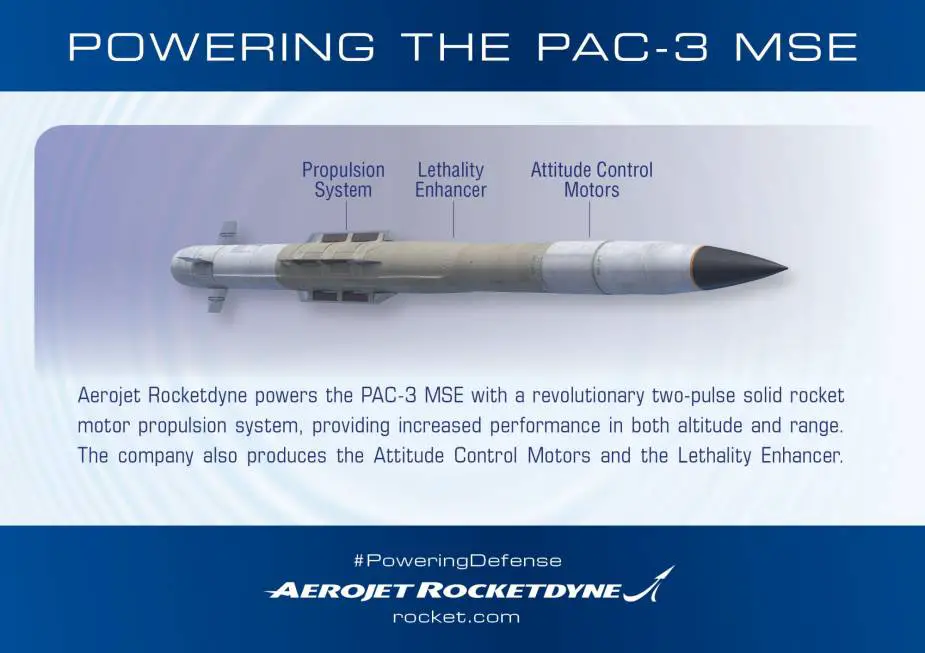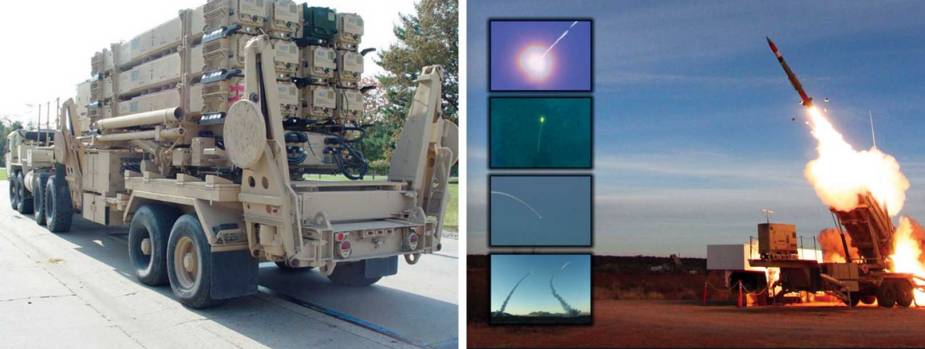Breaking news
German-modified M903 Patriot launcher successfully launches Lockheed Martin PAC-3 MSE Interceptor.
A German-modified M903 launcher successfully launched a Lockheed Martin Patriot PAC-3 Missile Segment Enhancement (MSE) interceptor in a flight test on May 11. The Germany Tactical Test / Operational Test 3 flight test was conducted by the German Air Force against a virtual tactical ballistic missile target to prove compatibility between PAC-3 MSE and the German-modified Patriot M903 launching station.
Follow Army Recognition on Google News at this link

Patriot PAC-3 MSE interceptor (Picture source: AeroJet Rocketdyne)
MBDA Deutschland partnered with Lockheed Martin to perform the necessary modifications of the launcher to enable the integration of the PAC-3 MSE missile. The test was a critical final step before Lockheed Martin delivers the first shipment of PAC-3 MSEs to Germany. “Delivering PAC-3 MSE to Germany will enhance German air defense capabilities and increase lethality against evolving threats,” said Dennis Goege, Lockheed Martin Vice President of Central and East Europe. “The recent flight test proves that PAC-3 MSE is ready for deployment in Germany.”
The Patriot missile has been upgraded continually since it was first deployed in 1982, and variations include the Patriot Advanced Capability-2 (PAC-2), Guidance Enhanced Missile-Tactical (GEM-T), PAC-3 Cost Reduction Initiative (CRI) and PAC-3 Missile Segment Enhancement (MSE) missiles.
The upgraded PAC-2 missile, originally used during the Gulf War, was a U.S. Army one-stage, solid-fuel, ground-launched interceptor designed to destroy tactical ballistic missiles, cruise missiles, or aircraft with a conventional high-explosive blast fragmentation warhead.
The Patriot GEM-T variant of the PAC-2 allowed the interceptor to detect low radar signature targets more effectively and have better detonation near ballistic missiles.
The PAC-3 CRI variant increased interceptor effectiveness by employing hit-to-kill technology versus conventional blast fragmentation. The PAC-3 MSE provided further performance enhancements with greater speed and maneuverability with a larger dual-pulse solid rocket motor and larger tail fins.
One of the key features of the PAC-3 MSE is its improved range and altitude coverage. It can engage threats at extended ranges and higher altitudes compared to its predecessor, making it highly capable of intercepting ballistic missiles, cruise missiles, and aircraft. This extended range allows the system to defend larger areas and protect critical assets from airborne threats.
The PAC-3 MSE utilizes a hit-to-kill interceptor missile that destroys incoming threats by directly colliding with them. This kinetic energy interception method ensures a high probability of target destruction and minimizes the risk of collateral damage. The interceptor is equipped with an advanced seeker that utilizes radar and infrared sensors to track and engage multiple targets simultaneously.
Another notable aspect of the PAC-3 MSE is its enhanced ability to discriminate between actual threats and decoys or countermeasures. The system's advanced radar and sensor technologies enable it to differentiate between real targets and objects designed to confuse or evade interception. This capability significantly increases the system's effectiveness in complex and challenging operational environments.
The PAC-3 MSE is also highly mobile and can be rapidly deployed to various locations to provide protection where it is needed most. It is integrated with a robust command and control system that allows for seamless coordination with other air defense assets and provides a comprehensive air picture to operators.
The U.S. and German governments reached an agreement in 2019 for the procurement of PAC-3 MSE. Germany already employed the PAC-3 Cost Reduction Initiative (CRI) interceptor in their air defense arsenal: the PAC-3 MSE missile is the primary interceptor for the German next-generation air and missile defense system, Taktisches Luftverteidigungssystem (TLVS).

The Phased Array Tracking Radar to Intercept of Target (PATRIOT) Missile protects ground forces and critical assets at all echelons from advanced aircraft, cruise missiles and tactical ballistic missiles (TBM) (Picture source: U.S. Army)


























